——— H ———
H – the symbol for henry.
HA – Hybrid Amplifier.
Haas effect – the ability of the human brain to perceive the location of a sound based on the time of arrival at each ear. Humans will perceive the direction of sound as the direction of the ear where the sound arrives first by up to about 25 ms, even if the later arriving sound is louder by as much as 10 dB. The second sound is perceived as the same sound originating from two different locations. If the second sound arrives later than 25 ms, it is heard as two distinct sounds. The effect is named for Helmut Haas, who described in his 1949 Ph.D. thesis. A similar effect, called the law of first wavefront was described by Lothar Cremer in 1948. Hans Wallach and others described a similar effect in 1949 which they called precedence effect.
Hafler circuit – a passive electronic circuit that extracts ambience from regular stereo recordings without using expensive electronics. It is named after audio engineer David Hafler, owner of Dynaco, who used it in a process he called the Dynaquad system, an early version of quadrasonic sound. Also called the Hafler hookup.
Hafler hookup – see Hafler circuit.
half bend – see bend.
half-cardioid pattern – a cardioid microphone polar pattern for a boundary microphone mounted on a flat surface. These microphones have a cardioid pattern only in the hemisphere above the mounting surface.
half-duplex – see full-duplex.

half normal – see normal.
half note – a music note having the time value of two quarter notes or half a whole note. In 4/4 time, a half note has the time value of two beats.
half-octave band – see one-half octave band.
half-octave equalizer – see one-half octave equalizer.
half-power beamwidth – see beamwidth.
half-power point – see 3-dB down point.
half rest – a rest that has the same length as a half note.
half-sampling frequency – see Nyquist frequency.
half space – the sound environment created when a loudspeaker is placed against a solid barrier, such as a wall. This situation yields an additional 3 dB of sound power level, especially in the bass frequencies, compared to a speaker in a free field. See also quarter space, ⅛ space, and quarter-wavelength null.
half step – see semitone.
half tone – see semitone.
half-track – see 2-track
hall effect – see hall reverb.
hall reverb – a reverberation effect that simulates the reverb typical of a concert hall. Because of the large size of the space, ir hall reverb has a very long decay—as long as several seconds. They are typically used for orchestral arrangements and to thicken and add space to strings and pads. However, they can really muddy up a mix if overused.
ham radio – see amateur radio.

Hamasaki square – a surround sound microphone technique used for the pickup of ambience, developed by Kimio Hamasaki, a research engineer with NHK Science & Technical Research Laboratories. It uses four bidirectional (figure-eight) microphones arranged in a square, spaced about 1.8 to 2 meters (6 to 6.5 ft) apart, facing outward with the microphone nulls pointing toward the main sound source so as to minimize the pickup of direct sound as well as the echoes from the back of the space. Ideally this array should be placed toward the back and high in the space. The back two microphones are mixed to the surround channels, while the front two channels are combined with the front left and front right signals. This technique is less sensitive to the distance between the main array and the ambience array than other ambience techniques.
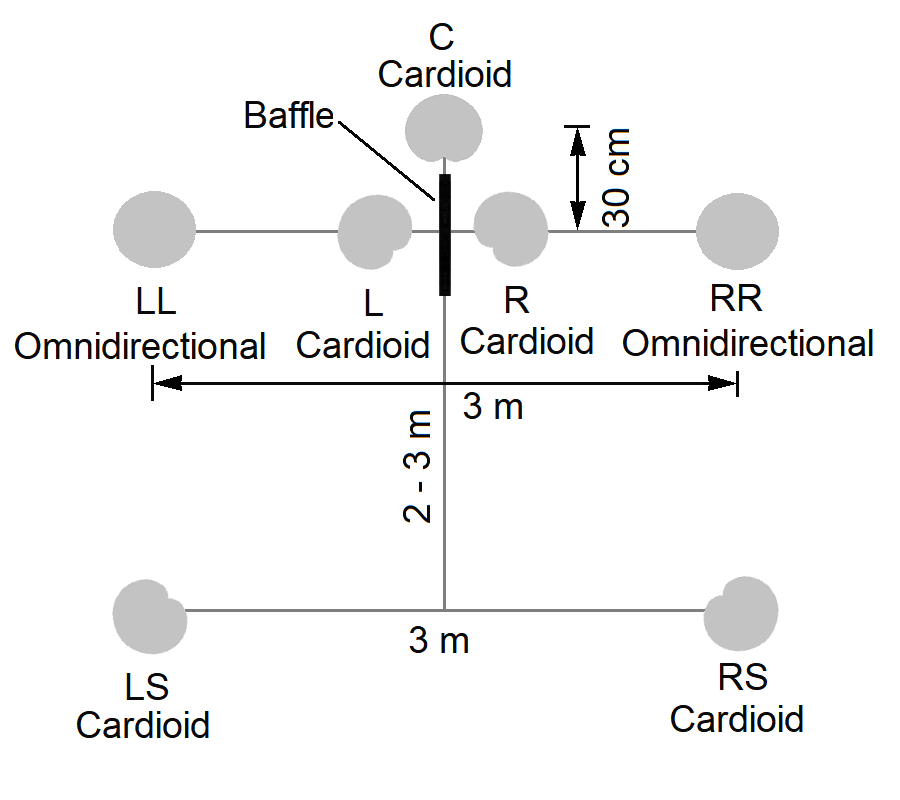
Hamasaki surround system – a surround sound microphone technique developed by Kimio Hamasaki, a research engineer with NHK Science & Technical Research Laboratories. It uses 5 cardioid and two omnidirectional microphones. A baffle is used to separate the left front and right front channels, which are 30 cm (12 in) apart and angled at 45 degrees. Two omnidirectional microphones, which are low-pass filtered at 250 Hz, are spaced 3 meters (10 ft) apart in line with the left and right cardioids. The center mic is placed about 30 cm (12 in) forward. The rear pair of cardioids are placed 2 to 3 meters (6 to 10 ft) behind front array and 3 meters (10 ft) apart, at an angle of 135°. Sometimes called the NHK surround system.
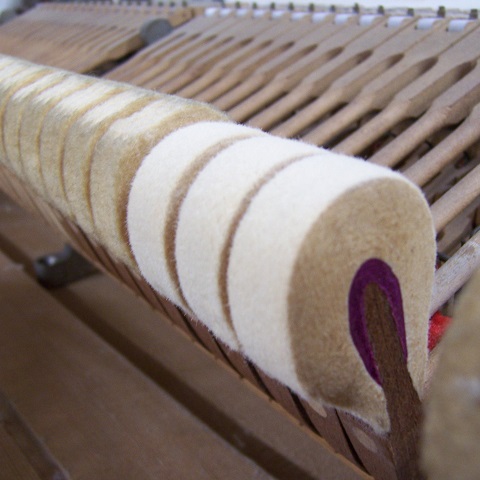
hammer – (1) The felt-padded devices inside a piano that strike the strings to produce a sound. (2) The device used to strike a xylophone, also called a mallet.
Hammond B-3 – an organ created by Laurens Hammond in 1954. When used with a Leslie® rotating speaker, it quickly became a favorite of jazz musicians, and later a staple of R&B and rock 'n' roll keyboardists.
Hammond USA – a manufacturer of electronic organs founded by Laurens Hammond and John M. Hanert in Evanston, Illinois in 1936. Beginning as the Hammond Clock Company in 1928, it became the Hammond Organ
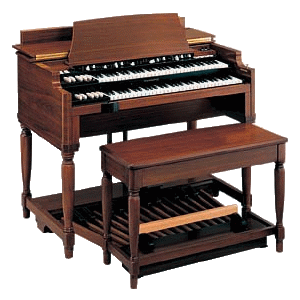
Company in 1936, and later moved its manufacturing facilities to Chicago. Laurens Hammond died in 1973, and the company fell on hard times going out of business in 1985. Parts and service continued to be provided by the Organ Service Company. In 1986, rights to the Hammond brand were acquired by Hammond Organ Australia, which were subsequently purchased by the Suzuki Musical Instrument Corporation in 1989, becoming Hammond-Suzuki. Today Hammond USA is a wholly owned subsidiary of Suzuki Music Corporation of Japan.
hand crossing – a guitar playing technique in which the picking hand frets or taps strings that are lower down the neck than the fretting hand, so that the picking hand crosses over the fretting hand. This procedure is similar to the cross-hand technique on a piano, where the right hand plays lower keys than the left hand.
handheld – a term for group of devices that are small enough to hold and operate in the hand, such as smartphones, tablets, and personal digital assistants.
handheld microphone – a microphone designed to be held in the hand, such as at a live performance. These mics are usually lighter in weight, but more sturdy than microphones designed to be mounted on a stand.
handling noise – (1) Noise introduced into a microphone through usage and movement, including vibrations transmitted through the microphone stand and mount. Many microphone mounts are designed to minimize these vibrations. (2) A specification used to compare how susceptible various microphones are to movement and shock.
hangover – a low frequency resonance that continues after the input signal has stopped. See also ringing.
Hansa reverb – a recording technique created by producer Tony Visconti and first used on the 1978 David Bowie song “Heroes,” which was recorded in the large concert hall in the Hansa recording studio in Berlin. Three microphones were placed at intervals across the length of the hall, one very close to Bowie, one halfway across the hall, and another at the far end, the latter two processed with gates. As the song was recorded, Bowie sang each verse progressively louder than the previous verse. With the increased volume in each verse, the gate threshold was set to open more of the distant mics, adding more room sound to the mix, increasing the amount of reverberation. In the first verse, Bowie's voice sounds up close, warm, and present. At the end of the song, Bowie's voice has much more reverberation and sounds more distant.
hard – (1) A descriptive term for a sound with good transient response, as if the sound was hitting you hard. (2) A descriptive term for sound with excessive upper midrange (around 3 to 4 kHz).
hard clipping – see clipping.
hard disk – see hard disk drive.
hard disk drive (HDD) – a data storage device used for storing and retrieving digital data on a computer, using rapidly rotating disks or platters coated with a magnetic material, and that retains the data even when powered off. Also called a hard disk or hard drive. See also hard disk drive interface.
hard disk drive controller interface – see hard disk drive interface.
hard disk drive (HDD) interface – the physical and logical method by which a hard disk drive connects to a computer. An HDD interface is also used to connect other peripherals, such as CD-ROM drives, removable drives, disk-based digital recorders, samplers, and other devices. Also called a hard disk drive controller interface, hard drive controller interface, disk drive controller interface, drive controller interface, hard drive interface, or drive interface. Advancements and improvements to the HDD interface has led to ever increasing number of names (and abbreviations). Here are some common types of interfaces:
•SASI (Shugart Associates System Interface) – an early industry standard interface introduced around 1978, that evolved into SCSI.
•ST-412 and ST-506 – standard interfaces for most small HDDs in the 1980s and early 1990s, introduced by Seagate Technology in 1980.
•ESDI (Enhanced Small Disk Interface) – a disk interface introduced in the early 1980s as an improvement to the ST-412/506 interface. It added control for other devices, such as removable disks and tape drives.
•SCSI (Small Computer System Interface) – an interface introduced in mid 1980s that can connect up to 15 drives and can connect both internal and external drives. It can use a 50-pin, 68-pin, or 80-pin connector. SCSI is pronounced “scuzzy.” SCSI-1 was the original SCSI standard adopted in 1986 by ANSI, which features an 8-bit parallel bus with parity, running in asynchronous mode at 3.5 MB/s or in synchronous mode at 5 MB/s, with a maximum bus cable length of 6 meters (19.7 feet). SCSI-2 was introduced in 1994 and provided for a maximum transfer rate of 10 MB/s (Fast SCSI) and a bus width of 16 bits (Wide SCSI), but with a maximum cable length of 3 meters (9.8 feet). SCSI-2 also provide for a 32-bit version of Wide SCSI, using two 16-bit cables per bus. The 32-bit version was officially retired with SCSI-3, which was introduced in 1996 that provided for a maximum transfer rate of 20 MB/s for narrow (8-bit) systems and 40 MB/s for wide (16-bit). The maximum cable length remained at 3 meters (9.8 feet). FireWire is a subset of SCSI-3.
•IDE (Integrated Drive Electronics) – an interface introduced in late 1980s that uses a 40-pin connector. It was later standardized as ATA (Advanced Technology Attachment). Retroactively became known as P-ATA or PATA (Parallel Advanced Technology Attachment) with the introduction of the Serial ATA.
•EIDE (Enhanced Integrated Drive Electronics) – an unofficial update of IDE by Western Digital, which supports hard drives larger than 512 MB, uses Direct Memory Access (DMA), the ATA Packet Interface (ATAPI) for optical and tape drives, and a 40-pin connector. Later called ATA-2.
•SATA (Serial Advanced Technology Attachment) – the serial version of the ATA introduced in 2003 that uses a seven-pin connector.
•SAS (Serial Attached SCSI) – a new interface introduced in 2004 that provides for much higher speed data transfers that is compatible with SATA.
hard-disk recorder (HDR) – a stand-alone or computer-based audio recording device that uses a computer hard disk drive. These systems can include features such as effects processing and digital mixing of the audio signal.
hard disk recording – using a computer hard disk drive to record audio signal that have been converted to digital data.
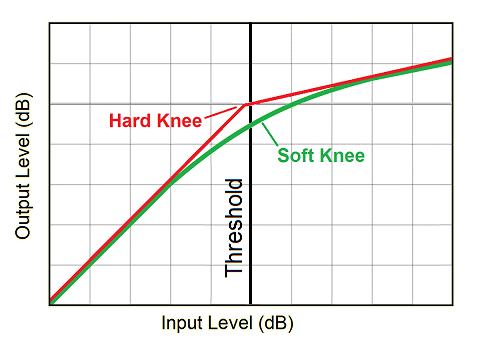
hard drive – see hard disk drive.
hard drive interface – see hard disk drive interface.
hard knee – a sharply defined change at the threshold level in a compressor as opposed to a gradual change (called a soft knee).
hard limiting – see limiting.
hard room – a room with highly reflective surfaces and very little sound absorption. The opposite of a soft room. See also anechoic chamber.
hard sync – a function available on some synthesizers that designates one oscillator as the master, while a second oscillator becomes the slave. When the master oscillator completes a wave cycle, it triggers the slave oscillator to begin its wave cycle from the start, no matter where in its cycle it may have been. This function creates a harmonically rich, edgy tone.
hardware – (1) Parts of a computer that you can actually touch, such as storage devices, display, keyboards, printers, boards, and chips, as opposed to the computer programs and data, which are called software. (2) Studio equipment such as mixers, preamps, and outboard equipment, such as compressors, reverbs, or equalizers.
hardware console – an actual console as opposed to a virtual console, such as a software DAW, virtual mixer, software audio console, or virtual audio console.
hardware digital audio workstation (DAW) – a hardware unit used in the 1970s to 1990s that consisted of a mixing console, data storage device, and an analog to digital converter (ADC). They could be used to record, edit, and playback digital audio. Although some are still in use today, they largely have been replaced by computer-based digital audio workstations (DAWs). Also called integrated digital audio workstation (DAW).
hardwire bypass – a true bypass of a effects processor in which the input signal is routed directly to the output, without passing through the processor or any other unnecessary circuitry, as opposed to a bypass that passes through a processor without acting on it.
hardwired – (1) A circuit in which connections are made by wires rather than etchings on a circuit board. (2) Used figuratively to refer to the configuration of mechanical or electronic components that cannot be changed by the user. (3) Used figuratively to refer to parameters of some software that cannot be changed by the user.
Harman International Industries, Inc. – an American audio equipment company headquartered in Stamford, Connecticut. The company designs, manufactures, and markets consumer and professional audio products for the home, car, theaters, and performance venues. Their product lines include loudspeakers, CD and DVD players, and amplifiers under several brand names including Harman/Kardon, JBL, AKG, Soundcraft, Infinity, dbx, AMX, Crown, DigiTech, Lexicon, IDX, Martin, Studer, SVSI, and BSS Audio. In 2017, Harman was acquired by Samsung Electronics.
Harman/Kardon – a company founded in 1953 by Sidney Harman and Bernard Kardon that manufactures home and car audio equipment. In 1956, Bernard Kardon retired and sold his interest to Sidney Harman. In 1962 Harman/Kardon merged with Jerrold Electronics, a firm specializing in the new cable TV business, becoming the Jerrold Corporation. Harman was unable to get along with the chairman, Milton Jerrold Shapp. After Sapp bought him out, Harman reentered business by investing in the Jervis Corporation, a small public company that manufactured jet engine and automobile components. Harman eventually took control of the company and sold off the parts business. In 1969 Jervis acquired the speaker manufacturer JBL. In 1976, while Sidney Harman served as Secretary of Commerce in the Carter administration, the company was sold to Beatrice Foods, but Harman re-acquired the company in 1978, renaming it Harman International Industries. In 1983, Harman acquired Infinity. Then in 1985, Harman repurchased Harman/Kardon from Jerrold. In 2017, Harman was acquired by Samsung Electronics.
harmonic – (1) Any of a series of musical tones whose frequencies are integral multiples of the fundamental frequency. While similar to an overtone, an overtone does not have to be an exact mulitiple of the fundamental, although it usually is. They are, however, numbered differently with the fundamental being the first harmonic, but the first overtone is equivalent to the second harmonic. See also partial. (2) Pertaining to, being related to, or having harmony.
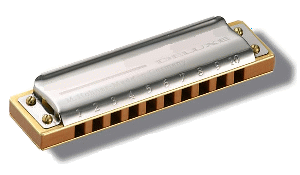
harmonica – a small rectangular wind instrument that produce sound by holding it in the player's mouth and blowing or sucking through a row of metal reeds running along its length and producing different notes by moving it from side to side. Also called a mouth organ, French harp, blues harp, or simply harp.
harmonic distortion – the presence of harmonics in an output signal that were not present in the input signal. Harmonic distortion is sometimes broken down into even-order and odd-order harmonic distortion, with even-order distortion producing harmonics with frequencies that are 2, 4, 6... times the fundamental, while odd-order harmonic distortion has 3, 5, 7... times the fundamental. It has been said that even-order harmonics produce a pleasing sound, while odd-orders do not, although this is not alway the case. The warmth of tube amplifiers is sometimes attributed to the presence of even-order harmonics. It should be noted that the amount of harmonic distortion varies by frequency and signal level. See also total harmonic distortion.
harmonic enhancement – see harmonic synthesis.
harmonic generation – see harmonic synthesis.
harmonic interval – see interval.
harmonic mean – a type of average, expressed as the expressed as the reciprocal of the arithmetic mean of the reciprocals. The harmonic mean H equals n/(1⁄x1 + 1⁄x2 + ...+ 1⁄xn) where x1, x2, ... xn are real positive numbers. See also geometric mean, and median.
harmonic minor scale – see minor scale.
harmonic parallelism, – see parallel harmony.
harmonic planing – see parallel harmony.
harmonic progression – see chord progression.
harmonic series – all the frequencies that are an integral multiple of the frequency of the fundamental. Humans perceive a harmonic series as a single pitch whose tonal quality is determined by the relative mix of the harmonic content.
harmonic series tuning – a tuning system or temperament based on the first sixty harmonics of the tonic. This system is not based on the usual diatonic scale as there are more notes per octave as the tuning progresses up the harmonic series. See also Pythagorean tuning, just intonation, mean-tone temperament, and equal temperament.
Comparison of Harmonic Series Tuning to Equal Temperament Tuning (12TET) |
|||||
| Based on Harmonic No. |
Frequency Ratio |
Interval (Cents) |
Equal Temperament Interval Name |
Equal Temperament (Cents) |
Difference (Cents) |
|---|---|---|---|---|---|
| 1 | 1.0000 | 0 | Unison | 0 | 0 |
| 17 | 1.0625 | 105 | Minor Second | 100 | +5 |
| 9 | 1.1250 | 204 | Major Second | 200 | +4 |
| 19 | 1.1875 | 298 | Minor Third | 300 | -2 |
| 5 | 1.2500 | 386 | Major Third | 400 | -14 |
| 21 | 1.3125 | 471 | Perfect Fourth | 500 | -29 |
| 11 | 1.3750 | 551 | Diminished Fifth | 600 | -49 |
| 23 | 1.4375 | 628 | Augmented Fourth | 600 | +28 |
| 3 | 1.5000 | 702 | Perfect Fifth | 700 | +2 |
| 25 | 1.5625 | 773 | Minor Sixth | 800 | -27 |
| 13 | 1.6250 | 841 | Minor Sixth | 800 | +41 |
| 27 | 1.6875 | 906 | Major Sixth | 900 | +6 |
| 7 | 1.7500 | 968 | Minor Seventh | 1000 | -32 |
| 29 | 1.8125 | 1030 | Minor Seventh | 1000 | +30 |
| 15 | 1.8750 | 1088 | Major Seventh | 1100 | -12 |
| 2 | 2.0000 | 1200 | Octave | 1200 | 0 |
harmonic synthesis – a technique used by aural exciters that creates new higher-order harmonics that are not present in the original audio, which can make a sound seem cleaner and more detailed. Also called harmonic enhancement, enhanced harmonic content, or harmonic generation.
harmonize – (1) To sing or play a harmony part with another singer or musician. (2) To add notes to a melody to produce harmony. (3) To produce a pleasing combination of sound.
harmonized scale – a series of chords created by using each note of a musical scale as the root note for the chord. Each chord along the scale is formed by taking the root and the third and fifth notes from the root at that point in the scale. For example, chord I of the C Major scale is C (root note), E (third note), and G (fifth note), which is the C Major chord. Chord II consists of D, F, and A, which is a D minor chord. In a similar manner, chord III is E minor, chord IV is F Major, chord V is G Major, chord VI is A minor, and chord VII is B diminished. In general, any diatonic scale would be written as I, ii, iii, IV, V, vi, vii (see Roman numeral analysis). Harmonized scales can be created with any type of scale or mode.
harmonium – see organ.
harmony – two or more performers, instruments, or sound sources simultaneously sounding a combination of the musical notes of a chord to produce a pleasing sound. Compare with unison.
harness – see wiring harness.
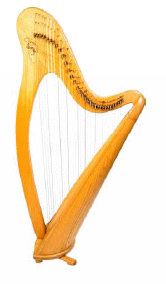
harp – (1) A stringed instrument, somewhat triangular in shape, having a sounding board and frame that supports a series of parallel strings. A harp is played by plucking the strings with fingers. Most modern harps have pedals that allow playing in various keys. (2) Slang for harmonica, short for French harp or blues harp.
HARP – Hollywood Association of Recording Professionals. An organization formed in the 1990s by recording studio owners in an effort to the stem the tide of home studios being opened in California. They used local zoning codes to force the closure of small studios who offered their services to outside clients.
Harrison Audio Consoles – a company founded by Dave Harrison in 1971, and based in Nashville, Tennessee, that manufactures mixing consoles and other audio products for the post-production, video, broadcast, sound reinforcement, and recording industries.
Harrison Mixbus – see Mixbus.
Harry Fox Agency (HFA) – an agency that collects and distributes mechanical license fees on behalf of music publishers in the US. It was founded in 1927 by the National Music Publishers Association. It was sold to SESAC in 2015.
harsh – a descriptive term for a sound that (1) has peaks in the upper midrange (about 2 to 6kHz) or (2) has too much phase shift caused by a low-pass filter.
hats – slang for hi-hat.
HATS – Head And Torso Simulator.
HAVi – Home Audio/Video interoperability.
hazy – a descriptive term for a sound with smeared detail and lacking focus. The sonic equivalent to looking through a dirty window. Similar to smeared and unfocused.
HCI – Host to Controller Interface. See Bluetooth controller.
HD – High Definition.
HDA – High Definition Audio.
HD Audio – High Definition Audio.
hdCD – see DVD.
HDCD – High Definition Compatible Disc. A new format developed by Pacific Microsonics (now part of Microsoft) for high-resolution audio on regular five-inch optical discs, that are like regular CDs except they are encoded at 20 bits or 24 bits, rather than the normal 16-bit resolution. They are compatible with regular 16-bit CD players, but a special HDCD player is required to reproduce the audio at 20 or 24 bits.
HDCP – High-bandwidth Digital Content Protection. A digital copy protection scheme developed by Intel Corporation to prevent copying of digital audio and video content as it is transmitted via certain intrfaces, such as DP (DisplayPort), DVI (Digital Visual Interface), and
HDMI (High-Definition Multimedia Interface). The system is designed to prevent HDCP-encrypted content from being played on unauthorized devices. Before a manufacturer can produces an HDCP-compatible device, it must obtain a license from Digital Content Protection, LLC (a subsidiary of Intel) and pay an annual fee.
HDD – Hard Disk Drive.
HD DVD – High Density Digital Versatile Disc. A digital optical disc format that was developed as a standard for high-definition video, but the competing Blu-ray disc (BD) eventually won out.
HDMI – High-Definition Multimedia Interface. The industry-supported, uncompressed, all-digital audio/video interface, carrying digital audio and video signals on a single cable.
HDR – (1) Hard-Disk Recorder. (2) High-Dynamic Range.
HD Radio™ – the trademark of iBiquity for the technology that provides for the simultaneous broadcasting of analog and digital signals by AM and FM radio stations using the current radio spectrum allocations. Although HD is a brand name and no longer stands for anything, it originally stood stood for Hybrid Digital. In 2002, the FCC selected HD Radio as the method to broadcast digital radio in the US, over several other competing technologies. The official name given by the FCC for this method is NRSC-5. iBiquity formerly called it IBOC (In-Band On-Channel).
HDRI – High-Dynamic Range Imaging.
HDS – HTTP Dynamic Streaming.
HD-SDI – High-Definition Serial Digital Interface. See Serial Digital Interface.
HDTV – High-Definition TeleVision.
HE-AAC – High Efficiency Advanced Audio Encoding.
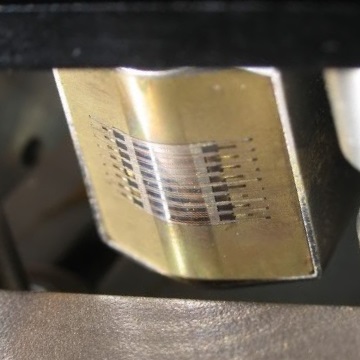
HE-AAC v2 – see High Efficiency Advanced Audio Encoding.
head – (1) A tape head. (2) The part of a device including the transducer that converts sound into electrical signals. (3) The amplifier in a 2-piece guitar amplifier-speaker combination, which usually sits on top of the speaker cabinet. Sometimes called a head unit. See also combo amp. (4) The beginning of a song or audio file. Also called the top. (5) The membrane or skin of a transducer that converts sound into electrical signals. (6) A drumhead.
head amplifier – an amplifier used at the source of an audio or video signal to boost a signal that would otherwise be too weak for the next stage in the signal chain. It can be thought of as a pre-preamplifier. An example is the preamplifier built-in to a microphone. Called a head amp for short.
head and torso simulator (HATS) – a dummy head and torso, with artificial ears and ear canals containing microphones, used to take acoustic measurements.
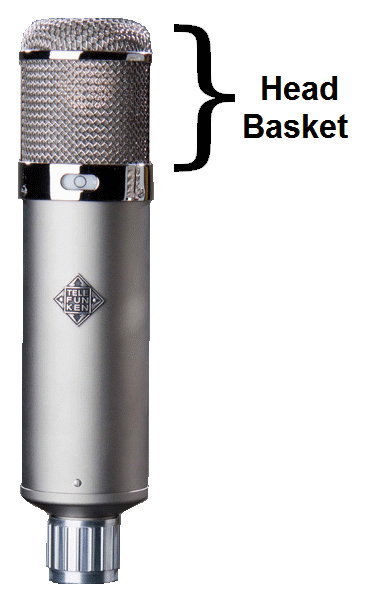
head basket – the wire mesh screen surrounding the capsule of a microphone. The head basket protects the capsule from physical damage as well as protects it from electromagnetic interference (EMI), such as ac hum and flourescent light emissions.
head block – the mounting onto which the head stack is attached.
head bump – an increase in low-frequency response of about 1 to 4 dB and 1 to 1½ octaves wide in the output of a tape machine. The amount and center frequency of head bump depends on the brand of machine and the tape speed.
header – metadata usually included at the beginning of an audio file that contains various information such as title, artist, date of creation, encription methods, error detection information, and other data.
head gap – see gap.
head locked – see binaural audio.
head-mounted display (HMD) – a device, worn on the head (or on a helmet in some applications), that provides a small display in front of each eye. HMDs are used in gaming (VR and AR), aviation, engineering, and medicine. Also called a head-mounted device or helmet-mounted display.
headphone amplifier – an amplifier optimized for driving headphones. Some headphone amps offers a variety of features such as independent outputs allowing several listeners the ability to control their own volume level, multiple inputs allowing users to select from among several sources, and independent tone controls for each listener. Sometimes called a cue box.
headphone drivers – the transducers in headphones that convert electrical energy into sound waves. There are five types of headphone drivers: (a) moving coil (dynamic), (b) balanced armature (BA), (c) planar magnetic, (d) electrostatic, and (e) magnetostriction (bone conduction). A moving coil driver consists of a magnet (usually neodymium), a voice coil, and a diaphragm. An electric current passing through the voice coil causes the diaphragm to move, causing sound in a similar manner to a dynamic loudspeaker. Moving coils are the most common driver as they are the least expensive. A balanced armature driver consists of a small arm (armature) inside a coil of wire surrounded by two magnets, with the armature being attached to a diaphragm. When the is no current, the armature is suspended between the two magnets and is balanced. When current flows through the coil, the armature pivots toward the magnets, causing movement of the diaphragm, which produces sound. A planar magnetic driver operates a principle similar to that of the dynamic driver, but instead of moving the voice coil, the magnetic field affects the diaphragm directly to produce sound. Since the whole diaphragm has to be vibrated, a planar magnetic driver requires larger magnets, which adds weight to the headphone and requires more power from the audio source. An electrostatic drivers uses static electricity to repel and attract the diaphragm to produce sound waves. Because this type of driver requires a special amplifier known as an energizer, it is usually found only in high-end headphones. Electrostatic drivers are more expensive and, therefore, are relatively uncommon. Bone-conducting (magnetostriction) headphones bypass the eardrum and send the vibrations directly to the inner ear via bone conduction. These headphones have limited fidelity, but offer advantages in certain situations, such as use by people with hearing problems or for use at times when the ears need to be left unobstructed, for example jogging near traffic. They are rarely used in the studio.
headphone mix – see monitor mix.
headphone out – an output with enough amplification to drive headphones. It is at considerably higher voltage than line level. Sometimes called headphone output.
headphone output – see headphone out.
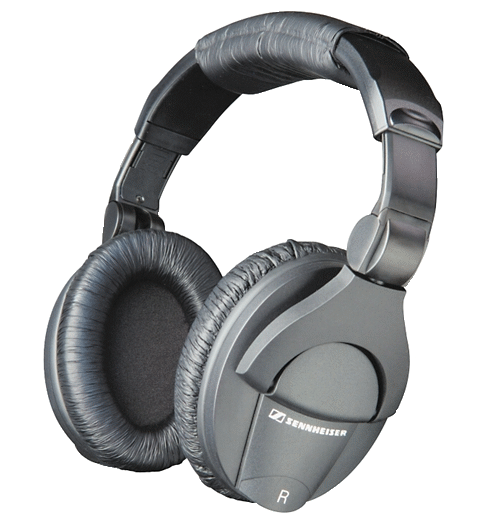
headphones – devices that can be worn on the head that cover or surround the ears with small speakers or sound transducers that convey audio sound waves, for the purpose of monitoring or recreational listening. There are three major operating methods for headphones: (a) dynamic headphones, (b) electrostatic headphones, and (c) planar magnetic headphones. There are several configuration of headphones: (a) over-ear ear buds, (b) in-ear headphones, (c) circumaural headphones, and (d) supraaural headphones. Circumaural phones can be either an open-back or a closed-back design. Also called earspeakers, earphones, or cans (slang).
head-related impulse response (HRIR) – see head-related transfer function.
head-related transfer function (HRTF) – a method of encoding audio so that a human ear perceives a sound as emanating from a particular point in space. The technique is used by some headphone manufacturers to simulate surround sound from stereo headphones or a pair of stereo loudspeakers. Another method of doing this is by capturing impulse responses that relate to sound locations. This response is called the head-related impulse response (HRIR). The HRTF is the Fourier transform of HRIR. The HRTF is sometimes called the anatomical transfer function (ATF).
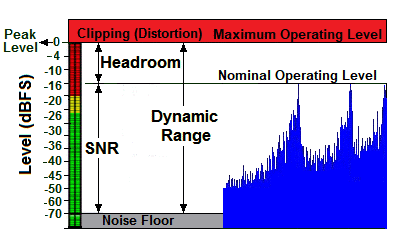
headroom – (1) The the difference between the level of the nominal operating level and the maximum operating level (peak level without distortion or overload), usually expressed in decibels (dB). Headroom = dynamic range - signal-to-noise ratio. Headroom provides a buffer zone to allow for unexpected transients without risking clipping. (2) In a tape recorder, the difference between the highest peak level and the level that will cause 3% total harmonic distortion. Sometimes called margin.
headset – a set of earphones or headphones, typically with an attached microphone.
head shadow – an acoustic shadow caused by the human head, an area of decreased sound level due to the sound being obstructed by the head. Because of the head shadow, a sound reaches the ear turned away from a sound (the shadowed ear) with much less intensity than the ear turned toward it, resulting in an interaural level difference (ILD) or interaural intensity difference (IID). The shadowed ear also receives a sound slightly later (approximately 0.7 ms), resulting in an interaural time difference. These differences along with interaural phase difference (IPD) are factors the human brain uses for localization. The amount of this difference varies with the frequency of the sound. Also called head shadowing.
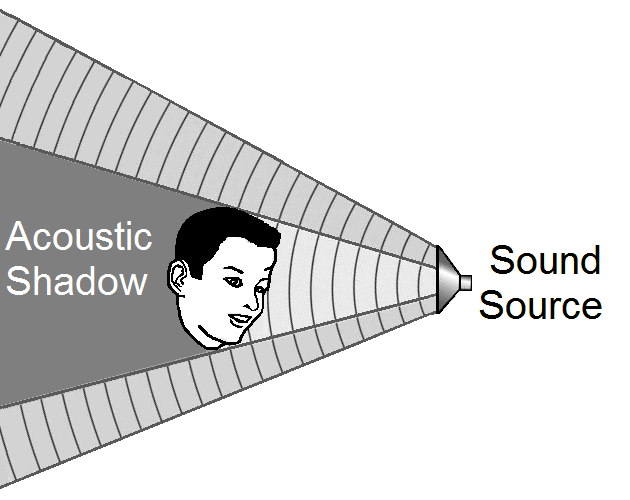
head shadowing – see head shadow.
heads out – a tape recording that has been rewound to the beginning and is ready to play. For long-term storage it is generally better to leave a recording tails out to minimize print through.
head stack – the assembly of heads in a tape recorder, usually consisting of two or three tape heads positioned on a head block. A two-head configurations consists of an erase head and a record/playback head. A three-head configuration contains an erase head, a record head, which usually is able to playback and act as a sync head, and a playback or repro (short for reproduce) head. The sync head is so called because it allows the engineer and musicians to be able to hear existing tracks in sync with new tracks being overdubbed.
headstock – the widened portion of a stringed instrument at the end of the neck, to which the tuning pegs are attached and the strings are wound. Also called a tuning head or peg head. On some instruments, it is called a scroll.
head tracking – a technology that detects the movement of a person's head in order to adjust sounds in headphones according to the position of the person's head.
head unit – see head, definition #3.
headworn microphone – a small microphone mounted on a short boom and held near a performer's mouth by a headband or similar device. Headworn microphones free up a singer's hands to play an instrument or perform other functions. Also spelled head-worn microphone.
hearing – the process of perceiving sound by the ear. Hearing is different from listening. The audible frequencies of human hearing (the audio spectrum) generally is considered to be between 20 Hz and 20,000 Hz (20 kHz), about 10 octaves. Other species have different hearing abilities.
hearing range – see audio spectrum.
heavy – a descriptive term for a sound with a good bass response (below 50 Hz). The opposite of light.
Heil air motion transformer – see air motion transformer.
helical – short for helical antenna.
helical antenna – an antenna that consists of a conducting wire wound in the shape of a helix and mounted over a ground plane. Called a helical for short.
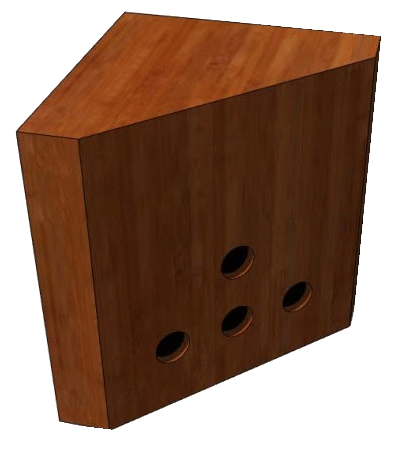
For a Corner
helical scan – a method of recording onto magnetic tape using a rotating head on a drum around which the tape passes at an angle to form a spriral (helical) tape path, thereby increasing the amount of data that can be recorded at a given tape speed. This technology is used in video recorders and DAT recorders. See also quadrature scanning.
Helios Professional Audio Limited – a manufacturer of recording studio consoles and other pro audio equipment, headquartered in Bristol, UK. It was established in 1969 as Helios Electronics Ltd. in Teddington, UK. It closed 1979, but was resurrected in 1999 as Helios Professional Audio Limited.
Helmholtz resonance – the phenomenon of air resonance in a space or cavity creating a sound, such as the that made when someone blows across the top of a bottle. It is named for Hermann von Helmholtz, who created a device now called the Helmholtz resonator in the 1850s. Helmhlotz studied acoustics and used the resonator to identify various frequencies and musical pitches in music and other sounds.
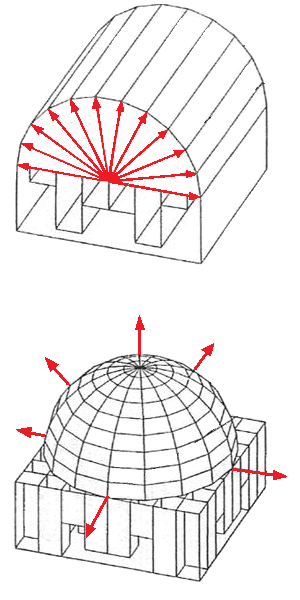
1-Dimensional Diffuser
(top) vs 2-Dimensionl
Diffuser (bottom)
Helmholtz resonator – an enclosure having a small opening and a size and shape that resonates at a single frequency as determined by its geometry. A Helmholtz resonators can be used to enhance or attenuate sound and are often used to reduce reverberation in spaces, such as a churches or auditoriums. The main advantage of the Helmholtz resonator is its simplicity, but it is effective over a relatively narrow frequency range. Therefore, in order to achieve significant attenuation it must be precisely tuned to the noise source of interest. Sometimes called a Helmholtz trap.
Helmholtz trap – see Helmholtz resonator.
hemiola – a musical term for a rhythmic pattern of syncopated beats with two beats in the time of three or three beats in the time of two.
hemispherical diffuser – a diffuser that scatters sound in a two-dimensional, hemispherical pattern. It consists of of a grid, with wells of varying depth, according to the matrix addition of two quadratic sequences equal or proportionate to those of a quadratic-residue diffuser. These diffusers are very useful for controlling the direction of the diffusion, especially in studios and control rooms. Also called a two-dimensional diffuser.
hemispherical polar pattern – a microphone pickup pattern that picks up sound in every direction above a plane. This type of pattern is achievable with a boundary microphones, also known as a Pressure Zone Microphone™ or PZM™ (trademarks of Crown International). These mics place a capsule nearly flush with a boundary (solid flat surface) to achieve a phase coherent capture of the sound around it.
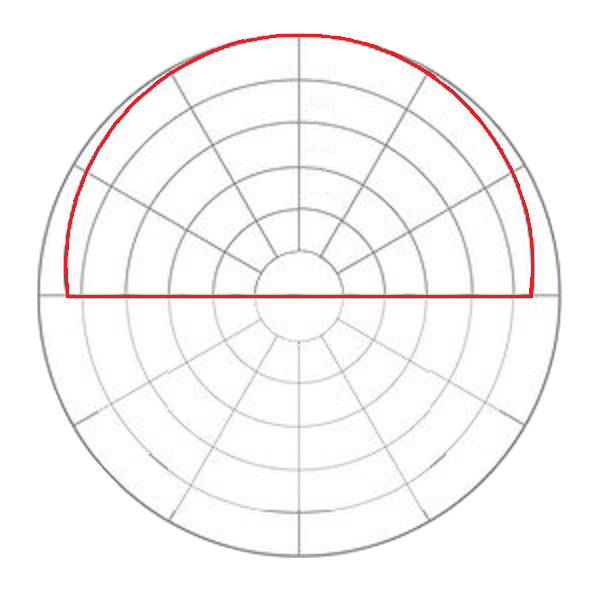
henry (H) – the unit for inductance, in which an induced electromotive force of one volt is produced with a current varied at one ampere per second.
Hermode Tuning (HMT) – a method in which software or plug-ins dynamically tune virtual instruments. Algorithms analyze harmonic structures and retune each note in the direction of just intonation, while remaining close to equal temperament. In this way the performance retains compatibility with familiar instruments, but makes them sound harmonically richer.
hertz (Hz) – the unit for measuring frequency. 1 hertz equal 1 cycle per second; 1,000 hertz (Hz) = 1 kilohertz (kHz). The term hertz, which was named for Heinrich Rudolf Hertz, who proved the existence of electromagnetic waves, was adopted in 1967. Before that, it was simply called cycles per second.
hertz per volt (Hz/V) – a method of specifying control voltage (CV) on some analog synthesizers to set pitch, where a given voltage represents a specific octave in the pitch range of the synthesizer and for each octave above that, the voltage doubles. The other main way of doing this is called volts per octave (V/oct).
heterophony – a musical style in which a single melody is played by multiple voices, with each performing the melody differently. The variations can include different rhythms or tempos or various styles, embellishments, and elaborations.
HEVC – High Efficiency Video Coding .
hexaphonic pickup – see divided pickup.
hex pickup – short for hexaphonic pickup. See divided pickup.
HF – High Frequency. The portion of the radio frequency spectrum from about 3 MHz to 30 MHz. See the radio frequency chart.
HFA – Harry Fox Agency.
HFP – Hands-Free Profile. See Bluetooth profile.
Hi 8 – an 8-mm video format primarily used for analog video recordings introduced as an improvement over the Video 8 system. For a while it was used by some manufacturers to record digital audio using the Digital Tape Recording System.
HiFi or Hi-Fi – see high fidelity, Beta HiFi, or VHS HiFi.
high action – see action.
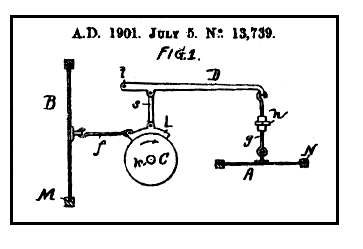
Patent for
Higham Amplifier
Higham amplifier – a mechanical amplifier invented in 1901 by Daniel Higham (pronounced “hi-am”) to increase the output from a phonograph. A tensioned cord attached to the stylus ran over a wheel which amplified the vibrations.
high definition (HD) – a term implying improved resolution or greater than “standard” resolution, such as high-definition video. In audio the term is sometimes used in reference to digital audio with resolutions greater than the usual 16 bits or with sample rates greater than the standard rates of 44.1 kHz (CD audio) or 48 kHz (DVD audio). See also high resolution audio and high definition audio.
high definition audio (HDA) – (1) Audio recorded at higher sample rates and bit depths than the normal CD specification of 44.1 kHz and 16 bits. See also high resolution audio. (2) An Intel specification called HD audio introduced in 2004 that provides for 2 to 16 channels of audio at sampling rates of 6 to 192 kHz and bit depths of 8 to 32 bits.
high-definition television (HDTV) – a standard for broadcasting television at a resolution that is substantially higher than that of standard-definition television. In the US, the ATSC established the standards for HDTV. It may be transmitted in several formats: 1080p (1920×1080p), 1080i (either 1920×1080i or 1440×1080i), or 720p (1280×720p), where the letter “p” stands for progressive scan while “i” indicates interlaced. Sometimes called high-definition video.
high-definition video – see high-definition television.
high dynamic range (HDR) – a dynamic range that is higher than standard dynamic range (SDR). The term is often used in photography, display devices, and sound recording, especially digital imaging and digital audio production. The term also applies to an analog or digital signal, or to the method of recording, processing, and reproducing such signals.
high-dynamic-range imaging (HDRI) – a technique used to reproduce a greater dynamic range of luminosity than is possible with standard digital imaging or photographic techniques. The goal is to present the human eye with a range of luminance similar to that encountered in real life. As the human eye encounters the broad range of changes of lighting in our environment, it adjusts constantly using the iris and other techniques, which the brain interprets allowing you to see a wide range of light conditions. There are two primary methods of creating high-dynamic range (HDR) images: (a) rendering by computer or (b) merging multiple low-dynamic-range (LDR) or standard-dynamic-range (SDR) images. HDR images can also be acquired using special oversampled image sensors. Because of the limitations of printing and display contrast, the extended range of an HDR image has to be compressed to be made visible. To render an HDR image to a standard monitor or printing device the overall contrast of an HDR image is reduced, using a process called tone mapping.
High Efficiency Advanced Audio Encoding (HE-AAC) – a lossy compression scheme for digital audio optimized for use with streaming audio applications where low bit rates are required such as internet radio and streaming music services. It is defined as an MPEG-4 audio profile. There are two versions of this compression system: HE-AAC and HE-AAC v2, with version 2 having more enhanced features and being more standardized than the first version. HE-AAC was created by introducing spectral band replication (SBR) into AAC-LC (AAC-Low Complexity), which went under the trade name of CT-aacPlus. HE-AAC v2, which was also developed by Coding Technologies, includes Perceptual Noise Shaping (PNS) technology, a type of perceptual modeling, and goes under the trade name Enhanced AAC+. Also known as aacPlus, aac+, CT-HE-AAC, eAAC, eAACplus, and eAAC+. See also AAC.
High Efficiency Video Coding (HEVC) – a video compression method, used as a successor to AVC. HEVC provides about double the data compression ratio at the same level of video quality as AVC or improved video quality at the same bit rate. It supports resolutions up to 8192 × 4320, including 8K UHD. Also known as H.265 and MPEG-H Part 2.
high end – (1) Slang for expensive or high quality. (2) The upper range of the audio spectrum, typically 5,000 Hz and above. It is sometimes further divided into high end (5 kHz to 10 kHz) and extreme high end (10 kHz to 20 kHz).
higher-order Ambisonics (HOA) – recording and playback techniques that have additional channels added to the original Ambisonics format that provide increased directionality components. The original Ambisonics signal set (first order) can be improved with second order, third order, etc., all of which are called higher-order Ambisonics. First-order Ambisonics (FOS) is essentially a three-dimensional extension of the mid/side (M/S) stereo technique, which adds difference channels for height and depth. First order has four channels, which behave like 3 figure-eight microphones plus one omnidirectional channel. Second order has an additional five channels for a total of nine. Third order requires sixteen channels. These channels correspond to the spherical harmonics, which are solutions to the Acoustic Wave Equation in spherical polar coordinates. Higher order formats do not correspond to conventional microphone polar patterns, but are shaped more like clover leaves. Primarily first- and second-order Ambisonics currently are being used. There are two different common channel ordering and weighting conventions for the first-order (B-format) Ambisonics: (1) The traditional B-format, as output by many commercial tetrahedron microphones, was proposed by Furse and Malham and sometimes abbreviated as B-format (FuMa) uses the .wav extension. (2) AmbiX, sometimes called B-format (ambiX), uses a different channel ordering and weighting scheme and uses the Wave-Ex format (WAVE_FORMAT_EXTENSIBLE) with the .amb extension. With Ambisonics, the sound field is defined for a listener at the center of the field using the axes X (front to back), Y (left to right), and Z (up and down). The B-format (FuMa) uses the channel order of W, Y, Z, X, with the W channel having an attenuation of -3 dB. The B-format (ambiX) uses the Ambisonics Channel Number (ACN) ordering, which is W, X, Y, Z. It also uses SN3D normalization, which for first order Ambisonics is essentially uniform gain for the X, Y, and Z channels. There is also N3D normalization, which varies slightly from SN3D, but rarely is used in the studio. Incidentally, zero-order is monophonic omnidirectional and uses only the W channel.
high fidelity – the high-quality reproduction of sound made on equipment with minimal noise, minimal distortion, and a flat frequency response. Such equipment began being produced in the late 1940s, replacing the poor quality sound produced by inexpensive and inferior audio equipment in use prior to that time. Also called hi-fi or hifi.
high-fidelity era – The era in which high-fidelity audio equipment began to become prominent. It corresponds roughly with the magnetic tape era.
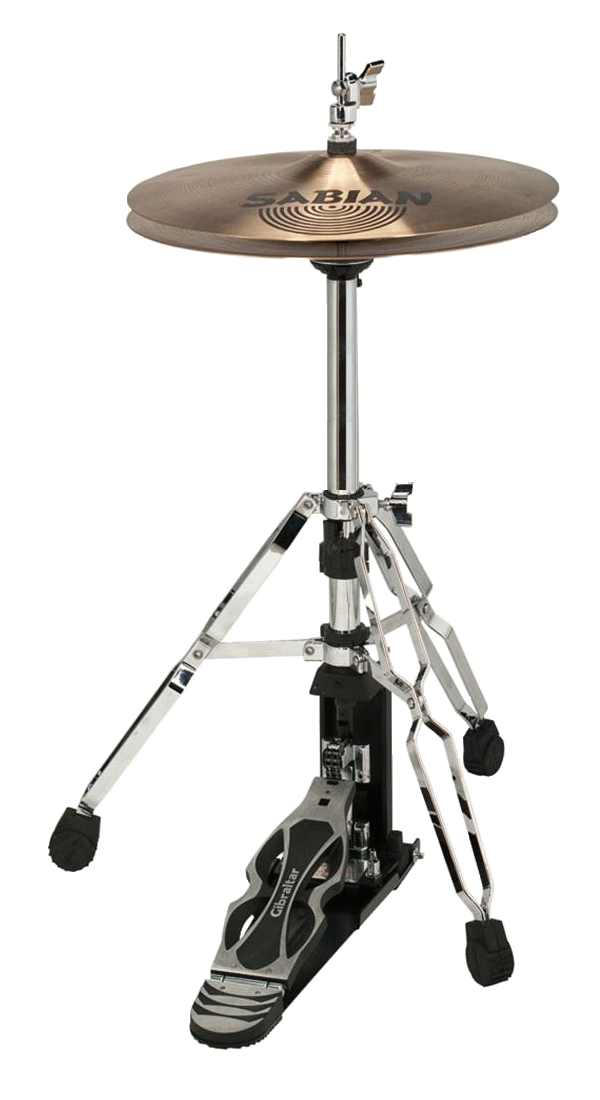
high frequencies – audio frequencies of 5,000 Hz and above. Sometimes called high-end frequencies.
high-frequency absorber – see porous absorber.
high-frequency compression – see Dolby HX Pro.
high-frequency driver – see tweeter.
high hat – a standard component of most drum kits, consisting of two cymbals mounted on a stand, one on top of the other and a foot pedal used to crash and hold them together. Sometimes called a sock cymbal. Also spelled hihat, hi-hat, or high-hat.
high-impact plastic – see Bextrene.
high-impact polystyrene sheeting (HIPS) – see Bextrene.
high impedance – an impedance typically of 5,000 ohms or more.
high-output low-noise (HOLN) – a formulation of metal particle tape that uses microscopic-sized particles of iron instead of iron oxide and designed to produce a very high sensitivity to magnetic fields and very low noise, for used in professional audio applications.
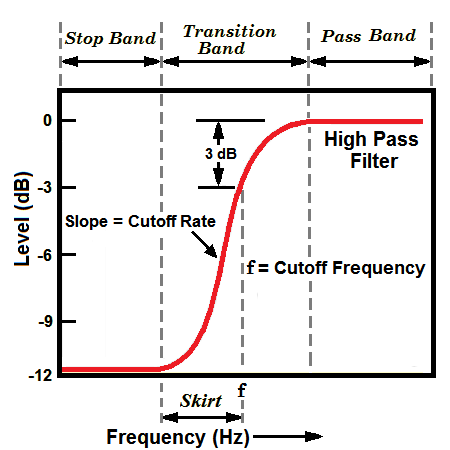
highpass filter (HPF) – a device that passes signals above a certain frequency (the cutoff frequency), but reduces the signal of frequencies below that. Sometimes spelled as the less-preferred high-pass filter. Also called a low-cut filter. See also lowpass filter, bandpass filter, allpass filter, notch filter, and slot filter.
high pitch – see A440.
high-res or high-rez – short for high resolution. See high-resolution audio.
high-resolution audio (HRA) – audio recorded at higher bit depths than the standard 16 bits of compact discs, such as 24 or 36 bits. Sometimes used interchangeably with high definition audio, which refers to both higher sample rates and bit depths, but technically high resolution refers only to resolution (bit depth).
highs – short for high frequencies.
high-strung tuning – see Nashville tuning.
hi-hat – see high hat.
Hi-MD – a revised version of Sony's MiniDisc (MD) system using a higher capacity disc as well as providing other improvements. Hi-MD equipment maintains playback compatibility with the older MiniDiscs.
hinge frequency – see shelving equalizer.
HIPS – High-Impact Polystyrene Sheeting. See Bextrene.
hi-res or hi-rez – short for high resolution. See high resolution audio.
Hirose connector – see HRS connector.
hiss – a noise containing all frequencies, but greater amounts of high frequencies. Magnetic recording tape and most microphones have a low level of hiss.
Hitachi, Ltd. – Kabushiki-gaisha Hitachi Seisakusho. A Japanese multinational engineering and electronics company headquartered in Chiyoda, Tokyo, Japan. It is the parent company of the Hitachi Group that is involved in a multitude of business ventures.
hit point – see cue point.
hi-Z – an abbreviation for high impedance.
HLS – HTTP Live Streaming.
HMD – Head-Mounted Display, Head-Mounted Device, or Helmet-Mounted Display.
H:M:S:F – abbreviation for Hours, Minutes, Seconds, and Frames in SMPTE timecode.
HMT – Hermode Tuning.
HOA – Higher-Order Ambisonics.
hold – (1) In music, a pause. (2) To prolong a note or rest. (3) The second of the six segments of an AHDSFR envelope.
hold time – a parameter used on some synthesizers that specifies how long the attack or sustain portion of an envelope should be held.
hole-in-the-middle effect – (1) The undesirable effect caused by a coincident pair of microphones being at too extreme an angle creating a stereo image that is all left and right with very little sound in the center. (2) A phenomenon created by a stereo or surround sound system where the loudspeakers are too far apart to deliver a balanced stereo image to the listener.
hollow – a descriptive term for a sound with too much reverberation or ambience or that has a dip in the midrange frequencies.
holophonics – the aural equivalent to holography. It is a binaural recording system developed by Hugo Zuccarelli based on his claim that the human auditory system acts like an interferometer. Based on phase variance, the sound characteristics of holophonics can be most clearly demonstrated using headphones and to a lesser extent using phase-coherent stereo speakers.
Home Audio/Video interoperability (HAVi) – an open standard developed by Panasonic, Philips, Sharp, Sony, Grundig, Hitachi, Toshiba, and Thomson for home networks designed to link consumer electronics devices, such as television sets, set-top boxes, DVD players, and other consumer products.
home electronics – see consumer electronics .
home keyboard – see electronic keyboard.
Home Recording Rights Coalition (HRRC) – a non-profit advocacy group of consumers, retailers, manufacturers, and other who want to protect the rights of consumers to view, listen to, and record radio and television broadcasts.
home recording studio – see home studio.
home studio – a recording studio setup in a private home. At one time, home studios were very expensive and were very similar to professional studios, and were owned primarily by professional recording artists who could afford them. Today professional audio equipment is much more affordable and home studios are now owned by hobbyists, independent bands, singer-songwriters, voice over artist, podcasters, and others. Sometimes used synonymously with project studio.
home theater – television and video equipment (often placed in a separate room in the home) designed to create an in-the-home experience of being in a movie theater, typically having a surround sound speaker system and a big-screen television set.
homophony – music in which the parts move together, sharing the melody and moving in the same rhythmic pattern. The opposite of polyphony, where the parts move independently with different interwovern melodies.
honky – a descriptive term for a sound with a peak in the frequency range of 500 to 700 Hz, which sounds like your voice when you cup your hands around your mouth. See also nasal.
honky-tonk piano – a piano outfitted with a mandolin rail to create the classic ragtime metallic sound popularized in player pianos and saloon scenes in old western movies. Sometimes thumbtacks or nails are placed on the felt-padded hammers of the piano (called a tack piano) to achieve this effect.
hook – a catchy part of a song, whether the melody, lyrics, or a riff, that grabs (hooks) the listener's attention.
hookup – (1) The connection between two devices. (2) To connect two or more devices, or to setup a system.
hoop – see rim.
horn – (1) A brass wind instrument, such as a trumpet or French horn. (2) An acoustic horn.
Hornbostel-Sachs – a widely used system for the classification of musical instrument devised by Erich Moritz von Hornbostel and Curt Sachs in 1914. Currently there are five classifications: electrophone, idiophone, membranophone, chordophone, and aerophone. Sometimes called Sachs-Hornbostel. See also see instrument families.

horn-loaded loudspeaker – see horn loudspeaker.
horn loudspeaker – a loudspeaker or loudspeaker element that uses a flared, horn-shaped duct that conducts sound waves to the open air. A horn uses physics to naturally amplify sound the same manner as a megaphone, and thereby improves the overall efficiency of the driver. Also called a horn-loaded loudspeaker.
horns – (1) The section of a band consiting of players of brass horns. Also called the horn section. (2) In a pop setting, trumpets, trombones, and saxophones, although strictly speaking a saxophone is a woodwind. Sometimes also called a horn section. (3) In an orchestra, usually only the French horns, but sometimes trumpets, trombones, French horns, and tuba, which is more often called the brass section.
horn section – see horns.
horn tweeter – see tweeter.
hose – a slang term for an audio cable or snake.
host CPU – the CPU on which the main audio software is operated. To free up resources from the host CPU, a DSP accelerator or DSP server is sometimes used.
hot – (1) Recording a track very close to clipping. (2) Recording to magnetic tape with a high level, causing slight distortion or tape saturation, sometimes used for effect. (3) A conductor, circuit, or other equipment that is carrying an electric current. (4) A microphone that is on and ready to receive audio.
hot swap – to change out a piece of equipment while the power is on. While this is often not a safe practice as it is potentially detrimental to the equipment, some devices are specifically designed to be able to be hot swapped.
house curve – in live sound reinforcement the adjustments made to the equalization to compensate for the anomalies of a specific venue (the “house”). The exact adjustment depends of the type of sound (speech or music), the size of the venue, and amount of reverberation. There is no standard curve, but some research has shown that a house curve that equalizes speakers to have a downward sloping response to be the most pleasing to the ear and to provide a more “listenable” sound.
house mix – in live sound reinforcement the mix of audio being presented to the audience in the auditorium (the “house”), as opposed to the monitor mix being sent to the performers.
house sync – a distributed synchronization signal, such as a SMPTE time code, used to synchronize two or more pieces of recording equipment in the studio.
howl – see feedback.
howlaround – see feedback.
howlback – see feedback.
howlaround – see feedback.
H-pad – a type of electronic attenuator circuit with a schematic in the shape of the letter “H.” An H-pad functions similarly to a T-pad, except it is designed for use with balanced lines. A T-pad maintains a constant impedance on both the input and output as the attenuation is changed. An L-pad holds either the input or the output impedance constant. All three attenuate signals independent of the frequency. They are called pads because they “pad” down the signal analogous to acoustics. Also spelled H pad.
HRA – High Resolution Audio.
HRIR – Head-Related Impulse Response. See head-related transfer function.
HRS Connector – a type of audio connector sometimes used to connect a wireless microphone to a wireless bodypack transmitter. The wiring configuration for these connectors has not been standardized within the wireless microphone industry. Also called a Hirose connector.
HRTF – Head-Related Transfer Function.
HRRC – Home Recording Rights Coalition.
HSP – HeadSet Profile. See Bluetooth profile.
HT – High Tension. British for high voltage.
HTDM – Host TDM. A special type of TDM that allows some host-based plug-ins to operate within the Pro Tools TDM environment.
HTML – HyperText Markup Language. The standard markup language for creating web pages and web applications. Web browsers use HTML to interpret and compose text, images, audio, and other data into visual or audible web pages. Page layouts are defined using HTML tags.
HTML tag – code words that define the layout and structure of an HTML page on the internet, including the placement of text, images, and hypertext links. The tags are shown between angle brackets [the less-than (<) and greater-than (>) symbols]. Tags such as <img> and <src> are used to input content. Tags such as <p> </p>or <bv</b> surround and define content and style.
HTTP – Hypertext Transfer Protocol.
HTTP Dynamic Streaming (HDS) – an adaptive HTTP-based media-streaming communications protocol developed by Adobe, that enables high quality streaming of media content over the internet using conventional HTTP web servers. Similar to Apple's HTTP Live Streaming (HLS) and MPEG-DASH, it is a technique used in streaming multimedia over the internet. It works by detecting a user's bandwidth and CPU capacity in real time and adjusting the quality of the stream accordingly.
HTTP Live Streaming (HLS) – an adaptive HTTP-based media-streaming protocol developed by Apple. It is an open format that uses conventional web servers and is widely supported by number of vendors. HLS is used to distribute both live and on-demand files. Similar to MPEG-DASH, it works by breaking the stream into a sequence of small chunks of data. As the stream is played, the client selects from various alternate streams encoded at a different data rates, so that the streaming session adapts to the available data rate.
hub – (1) The innermost part of a CD, which is made of clear plastic and includes the stacking ring, a thin ring of raised plastic on the bottom of each CD used to provide a small amount of space between each disc when stacking or shipping. (2) A tape hub. See also NAB hub.
Hubbell plug – see type A plug.
Huffman coding – an algorithm developed by David A. Huffman in 1952 while he was a student at MIT. The algorithm outputs a variable-length code table for encoding source symbols (the Huffman code), which is commonly used for lossless data compression. The Huffman code is based on the estimated probability or frequency of occurrence for each possible value of the source symbol, with more common symbols being represented by fewer bits than less common symbols. Most lossy audio codecs use Huffman coding.
HUI protocol – a proprietary communications protocol for interfacing between a hardware audio control surface and a digital audio workstation (DAW) to exchange MIDI signals that synchronize sliders, buttons, wheels, displays, and automation. This protocol was created jointly by Mackie and Digidesign (now Avid) in 1998 for the Mackie HUI (Human User Interface), the first hardware control surface for Pro Tools. The Mackie HUI was one of the first control surfaces that performed like a mixer, having eight channel strips with LED meters, and a transport controls, along with other editing and mixing features. The HUI protocol is used widely by other hardware controllers and DAW software. DAWs using this protocol are cross-compatible with HUI-compatible hardware controllers. Although HUI is still supported by many hardware makers, non-Avid software develpers have adopted the more open MCU (Mackie Control Universal) and other MIDI control protocols, while Avid has implemented controllers with proprietary protocols having much more extensive capabilities. See also EUCON
hum – an unwanted tone within an audio signal usually having a frequency or harmonic of 50 Hz or 60 Hz, caused by interference from the ac power supply. Sometimes called buzz.
human error – see operator error.
human hearing range – see audio spectrum.
humanize – a feature of some software plug-ins and MIDI sequencers to make effects and synthesized audio signals more natural-sounding by introducing small random variations in timing, duration, velocity, or other parameters to simulate the performance of a live musician.
humbucker – see humbucking coil.
humbucking coil – a device invented in 1934 by Electro-Voice that uses a double coil to reduce the amount of hum caused by picking up stray signals in microphones and other devices. A twin-coiled guitar pickup was invented by Arnold Lesti in 1935 to reduce hum. In 1938, A. F. Knoblaugh invented a pickup for stringed instruments involving two stacked coils, that was first used in pianos, since he was working for Baldwin Piano at the time. Also called humbucker, humbucking pickup, or double coil.
humbucking pickup – see humbucking coil.
humhead – slang for a sound engineer. Sometimes called a speakerhead.
hum killer – slang for isolation box.
hump – a wide peak in the frequency response.
humped – a descriptive term for a sound that up-front and forward, but still dull and thin. It is caused by a broad rise in the midrange and decreased lower and upper frequency ranges. Opposite of dished.
HWHM – Half Width at Half Maximum. See full width at half maximum.
HX Pro – see Dolby HX Pro.
hybrid – (1) A type of radio that combines digital audio processing with analog transmission. (2) Working in a digital audio workstation both in-the-box and out-of the-box.
hybrid amplifier (HA) – an amplifier that uses both transistors and vacuum tubes, in an attempt to attain the best characteristics of each.
hybrid picking – guitar playing technique that uses both a pick and one or more fingers to pluck the strings either simultaneously or alternately. Hybrid picking allows a player to use a pick to play riffs and to also play fingerstyle guitar. It also aids on making wide string leaps, such as from the sixth string to the first string, that would be difficult with a pick. The technique is most often used in rockabilly, country, and bluegrass music.
hybrid recording – recording a band or musical group using some combination of live recording (all-at-once recording) and overdubbing.
hybrid shield termination – a type of audio wiring in which the shield is attached to the metal chassis on the sending end and is attached through a capcitor on the receiving end.
hybrid TV – see smart TV.
hypercardioid microphone – a microphone with a hypercardioid pattern.
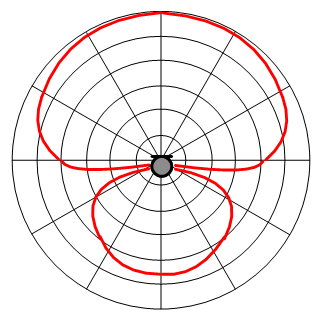
hypercardioid pattern – a microphone pick up pattern where the greatest sensitivity is in front and with the least sensitivity being at two points at about 110 to 120 degrees off axis and having a somewhat narrower pick up pattern than a cardioid pattern. See also polar pattern.
hypercardioid/lobar pattern – see lobar polar pattern.
hypersonic – (1) Pertaining to speeds that are more than five times the speed of sound (Mach 5). (2) Sometimes used to refer to frequencies that are above 100 MHz, with the term ultrasonic used for the range from 20 kHz to 100 MHz.
Hypertext Transfer Protocol (HTTP) – the protocol, developed by Tim Berners-Lee at CERN in 1989, used to exchange or transfer hypertext and which provides the foundation for data communication on the internet using the World Wide Web. Hypertext is structured text that links between points in documents containing text.
hype track – slang for a vocal track typically used in rap music that is used to add embellishments, such as “yeahs,” random shouts, and other phrases. Also called ad libs track or monkey track.
hypocardioid pattern – see subcardioid pattern.
hysteresis – the phenomenon in which the change in a value of a physical property lags behind the effect causing it. In other words, the state of a system depends on its history. A variable may have different values depending on the direction of change of another variable. Hysteresis is especially prominent in magnetic systems, such as when the magnetization of recording tape lags slightly behind the electromagnetic field produced by the recording head, resulting in distortion. This problem is partially overcome with the use of AC bias. Some audio compressors and expanders have hysteresis controls that determine the response depending upon whether a signal crosses the threshold moving upward or moving downward.
Hz – see hertz.
Hz/V – see hertz per volt.
Note: We believe this is the largest dictionary (glossary) of terms specific to usage within the recording industry that is currently available on the internet, with more than 8,800 entries, nearly 800 illustrations, and dozens of tables. Some of the terms have different or additional meanings in other situations, especially within the electronic, automotive, scientific, and computer industries. Of necessity there are obvious overlaps into other fields such as music, electronics, and computers, but such excursions are limited to information deemed pertinent to the knowledge required to operate and/or participate effectively in the workings of a recording studio. Also included are terms related to sound reinforcement (live performances) including wireless microphone technology because a working knowledge of that terminology is necessary for recording at live performance venues. Because recording studios also record audio for video and motion pictures (films), some terminology from those fields is included. Some scientific terms are included because they help explain studio terminology. For example, electromagnetism explains how microphones, loudspeakers, and guitar pickups work. Knowledge of radio waves and the radio frequency spectrum is needed to explain wireless devices. Any trademarks or trade names mentioned belong to their respective owners. The information contained in this dictionary is believed to be accurate at the time of publication. This information is subject to change without notice. The information was obtained from and cross-checked with a variety of sources that are believed to be reliable. However, Los Senderos Studio, LLC does not guarantee the accuracy or completeness of the information contained herein. Please contact us to report any errors, omissions, discrepancies, or broken links. Los Senderos Studio shall not be responsible for any consequences or damages arising out of the use of this information. Nothing in this glossary should be interpreted as legal advice. For a glossary providing information on legal and business matters for musicians, we suggest you consult Musicians Business Dictionary.
A note on alphabetical order: The terms in this glossary are alphabetical without regard to spaces and punctuation. For example, AM Radio follows amplitude. While this may seem to be at odds with other conventions, it eliminates confusion with words such as pickup, which is sometimes written as pick up or pick-up. In addition, all symbols such as &, -, or / are ignored. The entries on the number page (0-9) are listed in increasing value within each digit. For example, all of the entries beginning with 1 are listed before those starting with 2. For Greek letters (α-ω), the entries are in Greek alphabetical order.


